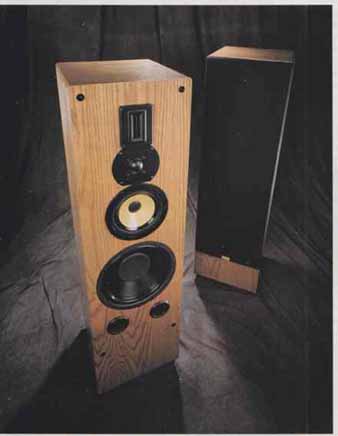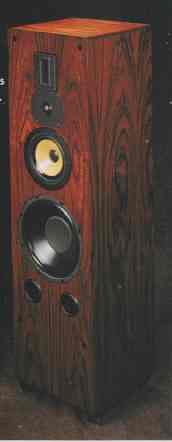In 1983, engineer Bill Duddleston, owner of Reel to Real Designs, introduced a speaker line that sold factory-direct, offering high-end speakers at lower than high-end prices. Thus, the Legacy speaker line was born, with the original Legacy-1 as its flagship.

Today, the company—now called Legacy Audio—still sells factory-direct, with a dozen audition locations scattered around the country and one in Canada. The line has grown to 12 speakers, including the well-received Focus, Signature III, Accent, and Whisper models; the pint-sized Studio; a variety of center-channel speakers; a couple of subwoofers; and the most popular speaker in the line, the $2,695-per-pair Classic.

The Classic is a floor-standing, four-way column system that exudes quality, especially for its price range. Available in standard finishes of black, walnut, or medium oak (as well as in a variety of optional premium finishes), the Classic contains a front-mounted, 10-inch poly propylene composite woofer, a 7-inch Kevlar midrange driver, a 1¼- inch titanium-dome tweeter, and a 4-inch ribbon super-tweeter. On the rear baffle are a second identical woofer and tweeter, which are said to augment the bass and enhance ambience. The front drivers are covered by a removable grille; the rear drivers are bare.
The Classic’s factory specifications list a frequency response of 22 Hz to 30 kHz, ±2 dB, sensitivity of 90 dB/ 1 watt / 1 meter, and crossovers at 120 Hz, 2.8 kHz, and 10 kHz. The recommended amplifier power is from 25 to 300 watts continuous.
The Classic is 44 inches tall, 12 inches wide, and 12 inches deep. At 110 pounds, it is no lightweight. The hardwood cabinet is extremely dense: Rapping it with bare knuckles yielded no hollow ringing. On the bottom rear panel is an array of five toggle switches that engage passive internal filters and control driver se lection for fine-tuning the speaker to the room. The switches for the passive filters become active only in their down positions, yielding a flat response when toggled up, according to Legacy’s informative owner’s manual. When you toggle it down, the first switch is said to reduce the level of the speaker’s midrange and treble by 2 dB, which is “passively equivalent to bass boost,” the manual states. The second switch notches the bass output by 3 dB at 70 Hz. The third reduces output in the lower treble region, while the fourth changes the speaker impedance from 4 to 6 ohms—the latter to make the load easier on smaller amps. The fifth switch defeats the rear-firing tweeter.
The two pairs of binding posts are linked by heavy copper jumpers for use with a conventional stereo amp, or the terminals can be used separately for bi-amping. On the bottom are factory-installed, gold-plated spikes.
I auditioned the Legacy Classics for several months with a variety of amps, pre amps, and program material. Eventually, I settled on a pair of 100-wan Pass Aleph 2 Class-A MOS-FET amps, a Pass Aleph P MOS-FET preamplifier, a Denon CD trans port with a Parasound D/AC-2000 HDCD D/A convertor, and Alpha-Core Goertz speaker cables and line-level interconnects. I also did some rudimentary room measurements with an AudioControl R130 real time analyzer (RTA) to see how the speakers interacted with my listening room.
After using a lot of muscle to move the 110-pound speakers into the room, I positioned them as recommended by the facto ry. When placed at least 3 feet from the front wall, the Classics are designed to yield flat frequency response at far-field listening positions 10 feet or more away. I found that at least 3 feet of space from the side wall was necessary in order to prevent audible heaviness around 80 Hz in my listening room. On some material rich in upper-bass energy, I used the bass-reduction switch to lighten the bottom end. For the most part, though, I preferred the flat settings for these switches. With the aid of the RTA, I got the Classics to produce fairly flat response at the listening position and noted that the speakers had substantial bass output at 20 Hz. That’s not too shabby for two 10-inch woofers.
My initial impressions of the Classic were quite good. The speakers produced an excellent soundstage with an openness and uncolored midrange and treble that I am accustomed to hearing only from high- quality ribbon-driver speakers. The bass was deep and tight, and the rear dome added an ambience that audibly collapsed (the degree depended on the source material) when I switched it off. I ended up keeping it active. I listened to some of my favorite audiophile discs, representing a range of musical styles. I first tried out the western-swing country music of Wylie & The Wild West Show’s Get Wild (Cross Tree Records 9405). This CD contains classic, re verb-soaked Telecaster twang and pedal- steel embellishments (“Devil Woman” is a prime example) that can be clearly heard with a high-quality speaker. These characteristics were duly delivered by the Legacy. Bass and drums were deep and tight with out strain at high levels. Depending on your amp, the Legacy can play as clean and loud as desired without strain.
On Johnny Frigo’s Debut of a Legend (Chesky JD119), the violin tone was about as good as I have heard. Recording engineer Bob Katz’s selection and careful placement of microphones for this performance made nuances of Frigo’s violin playing (e.g., plucked strings) stand out with the Classics. The liveness of the room was also preserved with these speakers.
I also listened to numerous recordings of orchestral works, solo violin, guitar, and lute, dating from the 1960s to present-day. They all sounded strong. I especially liked the precision of the plucked lute in Ronn McFarlane’s The Distant Shore (Dorian DOR-90242). Again, I really just cannot say enough about the sound of a well-implemented ribbon tweeter. It just adds that small degree of extra treble articulation without undue edginess.
On the other hand, the one liability of the Classic’s ribbon is its somewhat narrow vertical dispersion. If your listening position is above or below the ribbon’s ideal transmission path, high frequencies can sound a bit muted. Consequently, you need to sit in the sweet spot. I obtained the best sound with my ears about even with or just a few inches below the ribbon.
As an aside, I recently had recording/mastering engineer Tom Jung visit my house, and we sampled some of his just- completed audiophile jazz CDs, using the Legacy Classics as monitors. His general opinion, without having other speakers on hand, was that the Classic was in good company with more expensive Thiels and B&Ws. I agree. You would have to spend a lot more money to eclipse the performance of these speakers. I suppose that qualifies them as a genuine bargain.
As I mentioned earlier, Legacy sells factory-direct. You call them up, give them a credit card number, order a pair of speakers, and try them out for 30 days. If you like them, no problem. But if you’re unhappy, you can return them and your account is credited. While I don’t mind shopping that way, others may feel safer auditioning speakers in a showroom. I have bought gear from Legacy in the past, and the service was quite reliable. If you can live without the tire-kicking ritual of the retail hi-fi buying process, the savings can be substantial.
Adapted from 1998 Audio magazine article. Classic Audio and Audio Engineering magazine issues are available for free download at the Internet Archive (archive.org, aka The Wayback Machine)